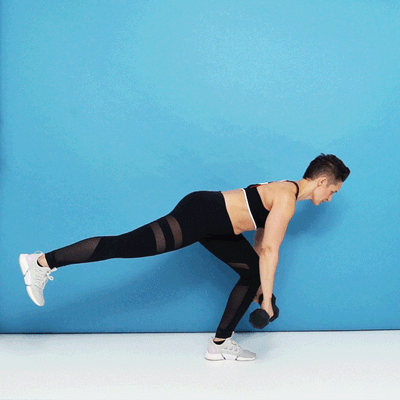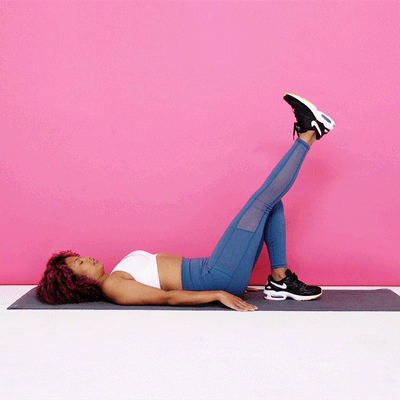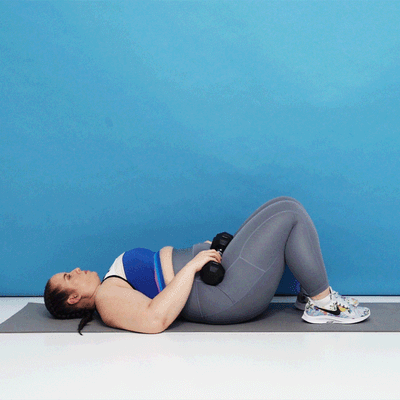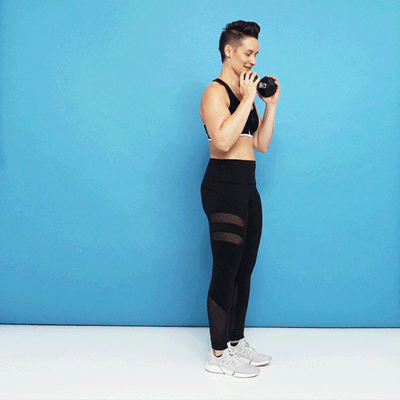
A Dumbbell Leg Workout That’ll Smoke Your Quads, Hamstrings, and Glutes
By Christa Sgobba
A solid dumbbell leg workout doesn’t involve pumping out endless squats; you want a lower-body routine that includes all the major movement patterns.
“The main thing is, in a good leg workout, you want to have all the basic compound movements,” says ACE-certified personal trainer Sivan Fagan, founder of Strong With Sivan in Baltimore, MD, tells SELF. tells SELF. “You want a hip hinge, a squatting pattern, a hip bridge pattern, and hip abduction.”
By incorporating these functional movement patterns into your leg workout, you’ll end up challenging muscles in the front of your lower body, like your quads, and in the back of your body, like your glutes and hamstrings. That makes it a comprehensive, intense lower-body workout.
But when we say intense, we don’t mean that you’ll be sweating all over the place. In fact, if you’re looking to get stronger (and maybe also build muscle), a leg workout that focuses on getting you sweaty isn’t going to be the best way to do it.
“If you’re focusing on speed, or doing as many reps as possible in a certain amount of time, and only taking a little bit of time to rest between sets, you’re not going to be able to lift as much weight, which is key to building strength,” says Fagan. “A workout that focuses on getting you as sweaty as possible or as fatigued as possible is not equal to an effective workout.”
That’s why in this five-move dumbbell leg workout from Fagan, you’re going to take the time for ample rest—1 to 2 minutes—between either straight sets or supersets (when you do two exercises back to back). This will give you time to recover, which will give your muscles the rest they need to be able to complete the same number of reps during your next set. Over time, you’ll notice you’re able to lift more weight or do more reps with the same weight. That’s progressive overload, and it’s vital to getting stronger.
You should rest long enough during your rest intervals for your heart rate to get back to near-baseline, but that doesn’t mean the workout will feel easy. You’ll be performing lots of compound moves—exercises that work multiple muscle groups across more than one joint—and sprinkling in a lot of unilateral, or single-legged work, too.
“When you are doing single-leg work properly and not rushing through it, it’s intense,” says Fagan. “It requires balance and core stability.”
The focus on unilateral work in this dumbbell leg workout is also particularly important now, as many of us are working out at home without access to our usual gym equipment. Unilateral leg exercises feel harder at lighter weights than bilateral exercises do, which make them super convenient for when you don’t have lots of weights at your disposal, says Fagan. (To continue to work on progressive overload when you can’t increase weight, you can slow down the tempo of the moves and add pauses—say, at the bottom of a lunge or top of a glute bridge—to increase time under tension for your muscles.)
Here’s what you need for a dumbbell leg workout that’ll smoke your muscles but rein in the sweat.
The Workout
What you need: A pair of dumbbells. (If you don’t have weights, you can use objects around your house, like water bottles or laundry detergent bottles.)
The Exercises
Straight set
- Single-leg deadlift to reverse lunge
Superset 1
- Single-leg glute bridge
- Weighted glute bridge
Superset 2
- 5 O’Clock Lunge
- Side-Lying Leg Raise
Directions
- For the straight set, complete 8-12 reps per side. Rest for 1-2 minutes. Complete 3 to 4 sets.
- For superset 1, complete 8-15 reps per side of the single-leg glute bridge, and 8-12 reps of glute bridge. Rest for 1-2 minutes. Complete 3 to 4 rounds.
- For superset 2, complete 12-15 reps per side of the 5 o’clock lunge and the side-lying leg raise. Rest for 1-2 minutes. Complete 3 to 4 rounds.
Demoing the moves are Amanda Wheeler (GIFs 1 and 4), a certified strength and conditioning specialist and co-founder of Formation Strength, an online women’s training group that serves the LGBTQ community and allies; yoga teacher Grace Pulliam (GIF 2); Rachel Denis, a powerlifter who competes with USA Powerlifting and holds multiple New York State powerlifting records (GIF 3); and Krystal Salvent (GIF 5), NASM-certified personal trainer in New York City.

1. Single-Leg Deadlift to Reverse Lunge
The single-leg deadlift to reverse lunge works both the hip hinge (with the deadlift component) and the squat pattern (with the reverse lunge component), says Fagan. (If you have trouble balancing, these single-leg deadlift tips can help.)
Stand with your feet together, holding a weight in each hand in front of your legs.
Shift your weight to your left leg and while keeping a slight bend in your left knee, raise your right leg straight behind your body, hinging at the hips to bring your torso parallel to the floor, and lower the weight toward the floor. (You may need to bend your knee a bit more depending on your hip mobility and hamstring flexibility.)
Keep your back flat. At the bottom of the movement, your torso and right leg should be almost parallel to the floor, with the weight a few inches off the ground. (If your hamstrings are tight, you may not be able to reach as far down.)
Keeping your core tight, push through your left heel to stand up straight and pull the weight back up to the starting position. Bring your right leg back down to meet your left. Pause there and squeeze your butt.
Then, step back (about 2 feet) into a reverse lunge with your right foot, landing on the ball of your right foot and keeping your heel off the ground. Bend both knees to create two 90-degree angles with your legs.
Push through the heel of your left foot to return to standing. That’s 1 rep.
Complete 8-12 reps, then switch sides.

2. Single-Leg Glute Bridge
Starting with the single-leg glute bridge (which works the hip bridge pattern) rather than the bilateral one helps you work on your mind-muscle connection, since you are focusing on isolating and engaging one butt cheek at a time, says Fagan.
Lie on the floor face up with your knees bent and feet flat on the floor. With your hands at your sides, your fingertips should come close to grazing your heels. Engage your core to press your low back against the floor.
From this position, lift your right foot off the floor and extend your leg.
Push off your left foot, engage your core and squeeze your glutes as you lift your hips and do a glute bridge.
Slowly lower your hips back to the floor.
Complete 8-15 reps on one side, then repeat on the other.

3. Weighted Glute Bridge
Because you’re engaging both sides of your body, you’re able to use more weight with a bilateral glute bridge, says Fagan. If you want to make it harder but don’t have access to heavier weights, you can increase the pause at the top.
Lie on your back with your knees bent, and feet flat on the floor hip-width apart. Hold a dumbbell in each hand, and rest them right under your hip bones. This is the starting position.
Squeeze your glutes and abs and push through your heels to lift your hips a few inches off the floor until your body forms a straight line from your shoulders to your knees.
Hold for a second and then slowly lower your hips to return to the starting position. This is 1 rep.
Complete 8-12 reps.

4. 5 O’Clock Lunge
Lots of exercises have you moving in the sagittal plane—front to back or back to front—but thanks to the rotational aspect here, you train movement in the transverse plane, says Fagan. This helps you move more efficiently.
Stand with your feet hip-width apart. Hold one dumbbell by both ends in front of your chest with your palms facing in toward each other and your elbows bent. This is the starting position.
Take a big step to the side with your right foot, rotating away from your body clockwise toward the 5-o’clock position.
Keeping your left leg straight, left foot flexed, and your chest lifted, bend your right knee and push your butt back to lower into a lateral lunge.
Push through your right heel to stand, rotating back to the starting position. That’s 1 rep
Do 12-15 reps on one side, and then repeat on the other side.

5. Side-Lying Leg Raise
The side-lying leg raise works hip abduction, or the movement of bringing your legs away from the midline of your body. It fires your gluteus minimus and medius, both of which are extremely important for hip stability and knee stability, says Fagan.
Lie on your left side, with your legs extended straight. Support your head with your left hand.
Lift your top leg 45 degrees, then lower slowly. This is 1 rep.
Complete 12-15 reps, and then repeat on the other side.







